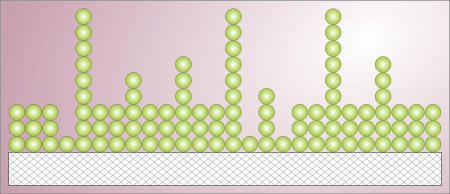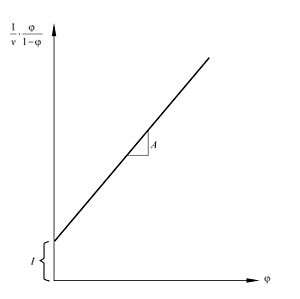BET theory
Brunauer–Emmett–Teller (BET) theory aims to explain the physical adsorption of gas molecules on a solid surface and serves as the basis for an important analysis technique for the measurement of the specific surface area of materials. In 1938, Stephen Brunauer, Paul Hugh Emmett, and Edward Teller published the first article about the BET theory in the Journal of the American Chemical Society.[1] The BET theory applies to systems of multilayer adsorption and usually utilizes probing gases that do not chemically react with material surfaces as adsorbates to quantify specific surface area. Nitrogen is the most commonly employed gaseous adsorbate used for surface probing by BET methods. For this reason, standard BET analysis is most often conducted at the boiling temperature of N2 (77 K). Further probing adsorbates are also utilized, albeit with lower frequency, allowing the measurement of surface area at different temperatures and measurement scales. These have included argon, carbon dioxide, and water. Specific surface area is a scale-dependent property, with no single true value of specific surface area definable, and thus quantities of specific surface area determined through BET theory may depend on the adsorbate molecule utilized and its adsorption cross section.[2]
Concept

The concept of the theory is an extension of the Langmuir theory, which is a theory for monolayer molecular adsorption, to multilayer adsorption with the following hypotheses:
- gas molecules physically adsorb on a solid in layers infinitely;
- gas molecules only interact with adjacent layers; and
- the Langmuir theory can be applied to each layer.
The resulting BET equation is
where and are the equilibrium and the saturation pressure of adsorbates at the temperature of adsorption, is the adsorbed gas quantity (for example, in volume units), and is the monolayer adsorbed gas quantity. is the BET constant,
where is the heat of adsorption for the first layer, and is that for the second and higher layers and is equal to the heat of liquefaction.

Equation (1) is an adsorption isotherm and can be plotted as a straight line with on the y-axis and on the x-axis according to experimental results. This plot is called a BET plot. The linear relationship of this equation is maintained only in the range of . The value of the slope and the y-intercept of the line are used to calculate the monolayer adsorbed gas quantity and the BET constant . The following equations can be used:
The BET method is widely used in surface science for the calculation of surface areas of solids by physical adsorption of gas molecules. The total surface area and the specific surface area are given by
where is in units of volume which are also the units of the monolayer volume of the adsorbate gas, is Avogadro's number, the adsorption cross section of the adsorbing species, the molar volume of the adsorbate gas, and the mass of the solid sample or adsorbent.
Derivation
The BET theory can be derived similarly to the Langmuir theory, but by considering multilayered gas molecule adsorption, where it is not required for a layer to be completed before an upper layer formation starts. Furthermore, the authors made five assumptions:[3]
- Adsorptions occur only on well-defined sites of the sample surface (one per molecule)
- The only molecular interaction considered is the following one: a molecule can act as a single adsorption site for a molecule of the upper layer.
- The uppermost molecule layer is in equilibrium with the gas phase, i.e. similar molecule adsorption and desorption rates.
- The desorption is a kinetically-limited process, i.e. a heat of adsorption must be provided:
- these phenomena are homogeneous, i.e. same heat of adsorption for a given molecule layer.
- it is E1 for the first layer, i.e. the heat of adsorption at the solid sample surface
- the other layers are assumed similar and can be represented as condensed species, i.e. liquid state. Hence, the heat of adsorption is EL is equal to the heat of liquefaction.
- At the saturation pressure, the molecule layer number tends to infinity (i.e. equivalent to the sample being surrounded by a liquid phase)
Let us consider a given amount of solid sample in a controlled atmosphere. Let θi be the fractional coverage of the sample surface covered by a number i of successive molecule layers. Let us assume that the adsorption rate Rads,i-1 for molecules on a layer (i-1) (i.e. formation of a layer i) is proportional to both its fractional surface θi-1 and to the pressure P, and that the desorption rate Rdes,i on a layer i is also proportional to its fractional surface θi:
where ki and k−i are the kinetic constants (depending on the temperature) for the adsorption on the layer (i−1) and desorption on layer i, respectively. For the adsorptions, these constant are assumed similar whatever the surface. Assuming an Arrhenius law for desorption, the related constants can be expressed as
where Ei is the heat of adsorption, equal to E1 at the sample surface and to EL otherwise.
Finding the linear BET range
It is still not clear on how to find the linear range of the BET plot for microporous materials in a way that reduces any subjectivity in the assessment of the monolayer capacity. Rouquerol et al.[4] suggested a procedure that is based on two criteria:
- C must be positive implying that any negative intercept on the BET plot indicates that one is outside the valid range of the BET equation.
- Application of the BET equation must be limited to the range where the term V(1-P/P0) continuously increases with P/P0.
Applications
Cement paste
By application of the BET theory it is possible to determine the inner surface of hardened cement paste. If the quantity of adsorbed water vapor is measured at different levels of relative humidity a BET plot is obtained. From the slope and y-intersection on the plot it is possible to calculate and the BET constant . In case of cement paste hardened in water (T = 97 °C), the slope of the line is and the y-intersection ; from this follows
From this the specific BET surface area can be calculated by use of the above-mentioned equation (one water molecule covers ). It follows thus which means that hardened cement paste has an inner surface of 156 square meters per g of cement.
Activated carbon
For example, activated carbon strongly adsorbs many gases and has an adsorption cross section of 0.162 nm2 for nitrogen adsorption at liquid-nitrogen temperature (77 K). BET theory can be applied to estimate the specific surface area of activated carbon from experimental data, demonstrating a large specific surface area, even around 3000 m2/g.[5] However, this surface area is largely overestimated due to enhanced adsorption in micropores,[6] and more realistic methods should be used for its estimation, such as the subtracting pore effect (SPE) method.[7]
Catalysis
In the field of solid catalysis, the surface area of catalysts is an important factor in catalytic activity. inorganic materials such as mesoporous silica and layered clay minerals have high surface areas of several hundred m2/g calculated by the BET method, indicating the possibility of application for efficient catalytic materials.
Specific surface area calculation
The ISO 9277 standard for calculating the specific surface area of solids is based on the BET method.
See also
References
- ↑ Brunauer, Stephen; Emmett, P. H.; Teller, Edward (1938). "Adsorption of Gases in Multimolecular Layers". Journal of the American Chemical Society. 60 (2): 309–319. doi:10.1021/ja01269a023. ISSN 0002-7863.
- ↑ Hanaor, D. A. H.; Ghadiri, M.; Chrzanowski, W.; Gan, Y. (2014). "Scalable Surface Area Characterization by Electrokinetic Analysis of Complex Anion Adsorption" (PDF). Langmuir. 30 (50): 15143–15152. doi:10.1021/la503581e. PMID 25495551.
- ↑ Sing, Kenneth S.W. (1998). "Adsorption methods for the characterization of porous materials". Advances in Colloid and Interface Science. 76–77: 3–11. doi:10.1016/S0001-8686(98)00038-4.
- ↑ J. Rouquerol, P. Llewellyn, and F. Rouquerol, Is the BET equation applicable to microporous adsorbents? In: Characterisation of porous solids VII. P. Llewellyn, F. Rodriguez-Reinoso, J. Rouquerol, and N. Seaton (Eds): Studies in Surface Science and Catalysis, 2007, 160, 49-56.
- ↑ Nakayama, Atsuko; Suzuki, Kazuya; Enoki, Toshiaki; Koga, Kei-ichi; Endo, Morinobu; Shindo, Norifumi (1996). "Electronic and Magnetic Properties of Activated Carbon Fibers". Bull. Chem. Soc. Jpn. 69 (2): 333–339. doi:10.1246/bcsj.69.333. ISSN 0009-2673. Retrieved 2015-06-26.
- ↑ Rouquerol, J.; Llewellyn, P. L.; Rouquerol, F. (2007). "Is the BET equation applicable to microporous adsorbents?". Characterization of porous solids VII. Studies in surface science and catalysis. Elsevier. pp. 49–56. ISBN 9780444520227.
- ↑ Kaneko, K.; Ishii, C.; Ruike, M.; Kuwabara, H. (1992). "Origin of superhigh surface area and microcrystalline graphitic structures of activated carbons". Carbon. 30 (7): 1075–1088. doi:10.1016/0008-6223(92)90139-N. ISSN 0008-6223. Retrieved 2015-06-26.